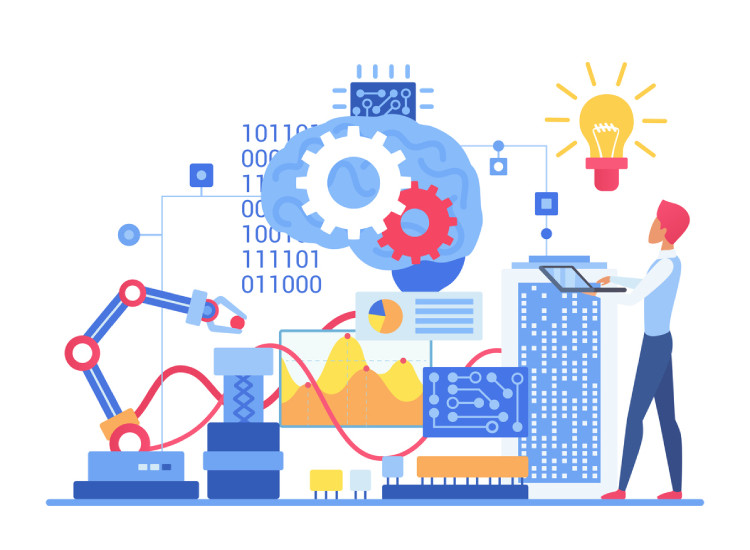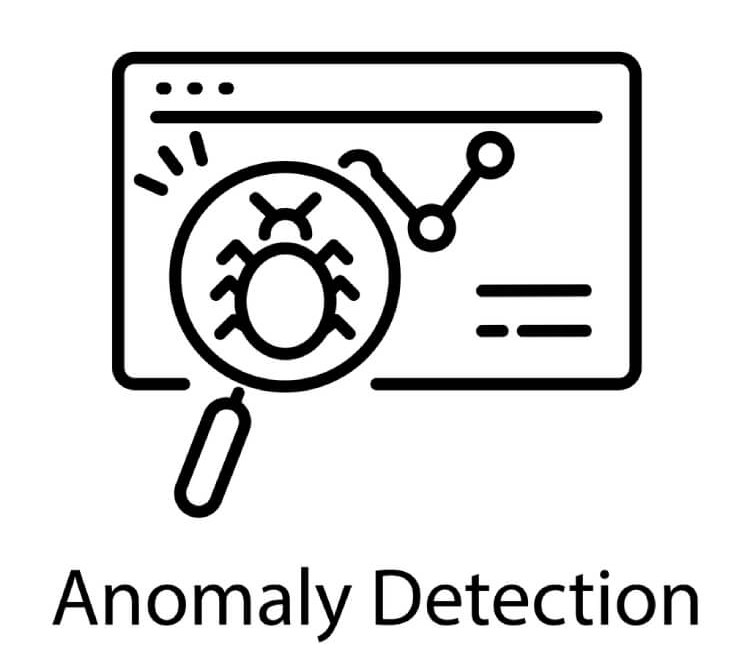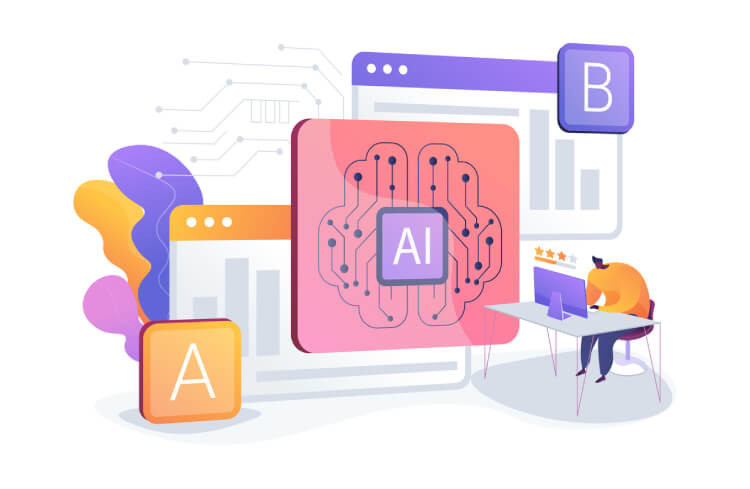How IIoT Enhances Machine Learning for Industry Efficiency
20-11-2024 | By Gary Elinoff

Process Optimization with Machine Learning.
Key Things to Know:
- The IIoT makes it possible for multiple data points, updated as often as need be, to be assembled at central points for analysis.
- Machine learning allows for machines to "learn" in a manner somewhat analogous to living minds.
- Important capabilities of these technologies include Predictive Maintenance, Anomaly detection and Process Optimization.
Introduction
There are a myriad of sensors available to designers that can measure important parameters such as temperature, pressure, vibration, humidity – the list goes on and on. Because these modern electronic sensors are light, inexpensive and consume scant power, they can be deployed freely on any device or system that needs to be monitored, such as a critical piece of capital equipment. But unlike the analog sensors of yore, they don't display results on a meter, which is valuable only to the inspector or technician physically close enough to visually read them. Instead, electronic sensors generate digital values, 1's and 0's, which can be transmitted to any point in the world.
The job of the IIoT (Industrial Internet of Things) is to transmit hundreds of independent sensor readings to a central point. This can be a control center located at the same physical location as the device or system being monitored, or to a data center located on the other side of the world. In either case, many hundreds of data points can be observed on a second by second basis. Engineers and planners can glean invaluable information on operational efficiency, and also explore the conditions that presage a failure.
Machine Learning (ML) allows computers to learn from experience. An issue may present itself, and at the same time, a number of data points switch to some noted values. Cause and effect? - perhaps not. The next time those same data points return the same values, the issue may not reoccur. ML then realizes that other factors are involved and looks for other inputs that may prove relevant.
In this manner, ML proves itself able to "learn" just as a living organism does. Over time, the ML engine builds up a library of patterns that may well provide insights that human analysts might otherwise miss.
The Industrial Internet of Things vs The Internet Of Things
There is no clear boundary between the IIoT and the Internet of Things (IoT). As described in IIoT Basics and Key Benefits of Industrial Internet of Things, the term IoT is generally reserved for consumer applications, such as the interface between a consumer's smartwatch and their smartphone. If that connection fails, the consumer suffers an inconvenience.
The IIoT refers to the connection between a critical system, such as a nuclear power plant, and the data center monitoring and controlling it. If this connection fails, catastrophe is the all too likely result. The bottom line is that reliability is an absolute must for most IIoT systems, while reliability is not quite so necessary for IoT systems.
In reality, the terms IoT and IIoT are often used interchangeably. And then, there is confusion between the IoT/IIoT terms and the general term "The Internet." Spoiler alert: it's the same internet, we generally just refer to "The Internet" when we are describing human communication, and either IIoT or IoT when it's machine to machine communication.
Mobile Connectivity
Devices to be monitored and controlled are often mobile, such as patients being monitored in a hospital setting. Even in an industrial plant, subsystems are often moved from place to place on the factory floor. Modern electric vehicles, often described as "computers on wheels", feature ever fewer components communicating to central points over wires or cables; rather, they also do so wirelessly. The reason is that wireless transponders are often cheaper than cables and more reliable.
Some of the major methods of wireless IIoT/IoT connectivity, in addition to the now well-known Bluetooth and Wi-Fi, include the LoRa (Long Range) and Zigbee wireless communication modalities.
More recently, cellular technology has had a role to play. There is NB-IoT, which can be deployed on 2G or 4G (LTE) networks. There is also a 5G technology known as 5G Red_Cap. This methodology only includes some of the vast arrays of 5G capabilities, with "Red_Cap" actually standing for "reduced capacity."
Each of these technologies has their place in the universe of wireless IIoT. They vary as to cost, bandwidth, power requirements and effective communication distance. The pluses and minuses of each are described in our report IoT Wireless Communication: The Core of Industrial IoT Connectivity.
The IoT, in its many forms, serves to garner information and assemble it at one or more central points so it can be analyzed by ML. The first, and perhaps most important application is Predictive Maintenance.
Predictive Maintenance
As described by IBM[1], "By collecting data from sensors and applying advanced analytical tools and processes such as machine learning (ML). Predictive maintenance can identify, detect, and address issues as they occur, as well as predict the potential future state of equipment, and so reduce risk. The key is providing the right information at the right time to the right people."
Predictive maintenance depends on the IIoT, which continually queries the multitude of sensors attached to the various points of interest on a system being monitored. Each sensor can be queried as often as desired. What is assembled is a library of readings, recording the moment-by-moment picture of the system's electro-mechanical condition. The IIoT transmits these readings to a central point, either locally or to servers located anywhere. It's here that analysis based on Machine Learning takes place.
A worrisome condition can occur on a machine or system being monitored, and at the same time, ML notes sensor values. Valuable information? Maybe not, because the next time the previous pattern is repeated, the bad condition may not be. And so it goes on. ML never sleeps, and it builds up a library of patterns that will guide analysts as to what's problematic and what's coincidental.
Notice the key difference between predictive maintenance and preventive maintenance. Preventive maintenance involves spending time, money, and resources, sending out technicians with voltmeters and oscilloscopes, and looking for the possibility of trouble when none may exist. Again, from IBM, "With predictive maintenance, corrective maintenance is only carried out only when there is a need to do so, and so avoids incurring unnecessary maintenance costs and machine downtime." [1].
Anomaly Detection
Anomaly Detection, aka Outlier Detection is a process employing machine learning that involves searching for events or statuses that deviate from what is expected or considered "normal." Applications include fields as different as fraud, data breach events, cybercrime and medicine.

ONIX[2] describes typical techniques used to identify anomalies in data in machine learning, including:
- Threshold-based methods. In this simple method, any value outside a set range is considered an anomaly. Of course, this simple approach produces many false positives.
- Probabilistic methods. Assumes a Gaussian distribution of values, with any data point outside the range that can be considered a possible anomaly.
- Distance-based methods. Often employs the k-nearest neighbor algorithm (k-NN). It points out anomalies based on distances to its nearest neighboring values.
- Clustering-based methods. Data points are grouped together, with values outside the cluster targeted as anomalies.
- Deep Learning Methods. Neural networks are employed to learn data patterns and identify problems.
Machine Learning for Process Optimization
Process automation, as the name suggests, involves analyzing the manner in which an entity does business and then endeavoring to improve it. This in itself is nothing new, but what is new is the employment of AI and Machine Learning to not only get better results but also to get those results faster.

ML improves process automation results.
As reported by Usemotion[3], AI components, including ML, computer vision, and natural language processing (NLP), are routinely enlisted in efforts geared toward processes optimization.
- Machine Learning recognizes patterns which can be optimized
- Computer Vision allows computers to gain information from visual cues
- Natural Language Processing (NLP) gains invaluable information from live or recorded human speech
AI can examine past results and ascertain what works and what doesn't. It can also detect inefficiencies and uncover mistakes. Beyond that, it may be possible to predict consumer behavior and even discover ideas for new services and products.
Akkio[4] reports that ML is "an effective tool because it can provide insights into customer behavior that would normally be overlooked. For example, a company may have a lot of data about people who filled out a contact form on their website, but they don't know if those people will convert, or how to optimize their website for better lead flow. With machine learning, they can train models to make predictions about who is more likely to buy."
ML can be used to predict future customer behavior based on past behavior. It might also be used to predict if a large customer might consider dropping a vendor. It can also be used to craft more effective marketing campaigns. Retailers can use ML based process automation to predict the effects of price changes on customer fidelity.
ML also makes it easier to personalize advertising and segmentalize users. Website specifics can be aimed at individual groups of users, as one size doesn't fit all. The same type of specificity can also be applied to marketing emails.
Challenges and Opportunities
It takes time for data point information to travel from a system being monitored and controlled to a data center located on the other side of the world and for calls to action to be transmitted back to the source. That time delay is called latency, and in critical cases, that time may be too long, as serious damage may have already occurred.
Another issue is just the sheer volume of data that may need to be transferred. As it stands now, it is estimated that as much as 5% of the world's electrical energy is devoted to powering data centers,
The situation will only get worse with the demands of not only this sector but also bitcoin mining.
The Electropages article entitled GaN and SiC Transform AI Data Centers Efficiency describes how wide bandgap semiconductors improves data center power efficiency, significantly cutting down on wasted power.
In another article, What is Edge Computing? The Future of Real-Time Data Processing, Electropages explores the concept of local decision making. This process greatly reduces the amount of data that needs to be transmitted over the IoT. And because the decision is made in very close proximity to the physical action points, latency can be largely eliminated.
Wrapping Up
The IIoT, in its various forms, can transmit large numbers of data point values to central hubs for analysis. These hubs can be located close to the physical action points, or to data centers located anywhere in the world. With the utilization of machine learning, systems can learn from experience, and can solve problems that they were never programmed to solve by any human hand.
Inexpensive data transceivers eliminates much of the need for physical cables, cutting costs and eliminating the need for troublesome re-cabling if a machine needs to be moved. It also makes it practical to apply machine learning to systems that are mobile by nature, such as military equipment. Classical mobility solutions include LoRa and Zigbee, with exciting new cellular-based technologies coming on fast.
Predictive Maintenance is one of the most widespread uses of these new technologies. Other important applications include Process Optimization and Anomaly Detection.
References
- What is predictive maintenance? IBM
- Anomaly Detection Using Machine Learning: Techniques and Applications. ONIX
- What Is AI Process Optimization? Usemotion
- 13 Examples of Machine Learning for Marketing. Akkio
Glossary of Terms
- Predictive Maintenance. The process whereby computer systems use historical failure data to predict future issues without human effort.
- Preventive Maintenance. A predefined schedule of actively looking for issues that may affect system performance
- Machine Learning (ML). A central branch of AI that allows computers to respond to developing conditions that they have never been specifically programmed for

